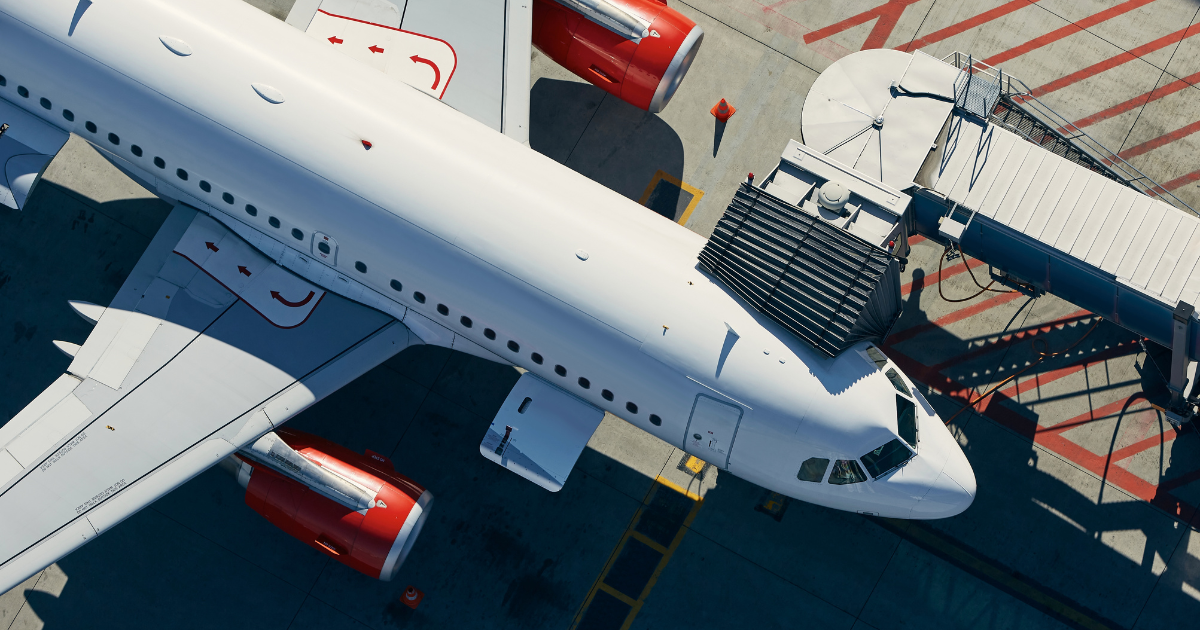
April 10, 2025
Hyper-Personalization in Aviation and Airline Industry: AI Use Cases Beyond Basic Recommendations
Author:

CSO & Co-Founder
Reading time:
12 minutes
The aviation industry is undergoing a significant transformation, with personalization emerging as a critical competitive differentiator. Airlines are increasingly shifting towards passenger-centric business models, recognizing that delivering tailored experiences is essential for enhancing customer loyalty and satisfaction.
This article explores the core issues surrounding personalization in the aviation industry, examining the limitations of current approaches and the transformative potential of AI, while at the same time navigating the reader from understanding to conclusion.
The Current State of Personalization in Aviation
Airlines currently employ various basic personalization techniques, including targeted marketing emails based on past travel history, pre-selected seat preferences for frequent flyers, and customized loyalty program rewards.
However, these traditional approaches often fall short of meeting the rising expectations of modern travelers. A significant gap exists between what passengers desire – seamless, real-time, and context-aware interactions – and the capabilities airlines currently offer.
Industry leaders like Emirates and Singapore Airlines are making strides by leveraging data analytics and customer relationship management (CRM) systems to offer more personalized flight recommendations and in-flight services.
Still, there’s ample room for innovation.
AI as the Foundation of Next-Generation Personalization
Artificial Intelligence (AI) is rapidly becoming the foundation of next-generation personalization in aviation, enabling airlines to move beyond rudimentary techniques and deliver truly hyper-personalized experiences.
Core AI technologies driving this transformation include:
- Machine Learning (ML): ML algorithms can analyze vast datasets of passenger behavior to predict individual preferences for flight times, meal choices, and entertainment options.
- Natural Language Processing (NLP): NLP empowers airlines to understand customer intent through chatbots, voice assistants, and sentiment analysis of customer feedback.
- Computer Vision: Computer vision technologies can optimize the passenger journey by facilitating facial recognition for expedited check-in and security clearance processes.
- Big Data Analytics: Big data analytics enables airlines to identify patterns and trends across massive datasets, providing valuable insights for personalized marketing campaigns and operational improvements.
These technologies work synergistically to create a holistic personalization ecosystem.
Example: Lufthansa utilizes ML to predict meal preferences and personalize in-flight dining experiences, while KLM employs NLP-powered chatbots to provide real-time booking assistance and customer support.
End-to-End Personalization Journey Mapping
It is incredible to note how now AI is able to improve each stage of the customer experience. This is done not only by augmenting the technological impact but also reviewing each and every phase, and by simply putting AI as a beacon of change.
For instance:
Booking Phase
- AI-Driven Recommendations: Based on past behavior and preferences, AI algorithms can recommend optimal flight options, including preferred departure times, layover durations, and cabin classes.
- Dynamic Content Adaptation: Booking platforms can dynamically adjust content based on individual passenger profiles, displaying personalized offers and promotions.
- Personalized Service Offerings: AI enables airlines to offer customized service packages tailored to individual needs, such as priority boarding, lounge access, and travel insurance.
- Conversational AI: AI-powered chatbots (most impressively the KLM case) provide natural language booking assistance, allowing passengers to easily modify itineraries, select seats, and request special services.
Pre-Flight Phase
- Customized Pre-Flight Communications: Airlines can send personalized pre-flight communications, including reminders about upcoming flights, gate changes, and baggage allowance information.
- Personalized Check-In Experiences: Mobile apps can provide personalized check-in experiences, offering seat upgrades, baggage tracking, and digital boarding passes.
- AI-Optimized Airport Navigation Assistance: AI-powered navigation tools can guide passengers through the airport, providing real-time directions to gates, restaurants, and other amenities.

Read more: Passenger Experience AI Assistance Bot

In-Flight Phase
- Cabin Crew Empowerment: Cabin crew members can access passenger preference data via tablets, enabling them to deliver more personalized service and proactively address individual needs.
- Personalized In-Flight Entertainment Recommendations: AI algorithms can recommend in-flight entertainment content based on viewing history and preferences.
- Customized Meal and Service Timing: AI enables airlines to customize meal and service timing based on passenger preferences, dietary requirements, and flight schedules.
Post-Flight Phase
- Follow-Up Communication Strategies: Airlines can send personalized follow-up emails, thanking passengers for their business and soliciting feedback on their travel experience.
- Personalized Loyalty Program Interactions: AI can personalize loyalty program interactions, offering tailored rewards, bonus miles, and exclusive travel deals.
- AI-Driven Feedback Analysis: AI-powered sentiment analysis can analyze customer feedback from surveys and social media to identify areas for service improvement.
- Predictive Modeling: Predictive modeling can forecast future journey preferences, enabling airlines to proactively offer personalized travel recommendations and incentives.
Cross-Channel Data Integration: The Foundation of Hyper-Personalization
Hyper-personalization hinges on seamless data integration across all passenger touchpoints:
- Booking Systems: Integrating data from online booking platforms, travel agencies, and global distribution systems (GDS).
- Airport Interactions: Capturing data from kiosks, check-in counters, security checkpoints, and airport lounges.
- In-Flight Transactions: Tracking purchases of meals, beverages, merchandise, and in-flight entertainment.
- Social Media: Monitoring social media conversations and sentiment related to the airline brand.
- Partner Ecosystem Touchpoints: Integrating data from hotels, car rental agencies, and other travel partners.
Integrating these diverse sources presents formidable technical hurdles, such as:
- Legacy System Incompatibility: Airline reservation systems built on decades-old mainframe technology using proprietary languages that weren’t designed for modern integration.
- Data Format Heterogeneity: Each system (reservations, operations, loyalty, ancillary services) uses unique data models, formats, and taxonomies with inconsistent standards.
- Synchronization Challenges: Reconciling real-time systems (website interactions) with batch-processed systems (revenue management) creates timing mismatches and data currency issues.
- Volume and Velocity Constraints: Processing billions of data points from millions of passengers while meeting strict performance requirements for real-time personalization.
- Passenger Identity Resolution: Difficulty matching a single customer across multiple systems where they may be represented differently (loyalty number vs. booking reference vs. email).
- Regulatory Compliance Complexity: Meeting stringent regulations for data privacy (GDPR), security, and cross-border transfers while maintaining integration functionality.
- Historical Data Limitations: Legacy systems often have restricted historical data access or purge older data, creating challenges for long-term customer journey analysis.
- Operational Data Silos: Flight operations, ground handling, and customer service platforms often operate independently with limited integration capabilities.
- Incomplete Data Visibility: Partner airline codeshares and alliance activities create blind spots where complete passenger journey data isn’t fully accessible.
- Inconsistent Data Quality: Varying levels of data completeness, accuracy, and standardization across systems requiring extensive cleansing and harmonization.
This complexity necessitates a collaborative approach that few organizations can achieve independently. AI and data engineering specialists bring critical technical capabilities: expertise in designing data lakes optimized for aviation’s unique requirements, deep knowledge of integration patterns that can bridge decades-old systems with modern cloud architecture, and proficiency with advanced data pipelines capable of handling aviation’s complex relationships.
However, technical expertise alone is insufficient. Equally crucial is aviation domain knowledge that provides intimate understanding of passenger journey touchpoints and how data flows between them.
Domain experts bring:
- Insight into industry-specific data models and their complex interdependencies
- Awareness of operational constraints that impact how and when data can be processed
- Recognition of business-relevant signals within the noise of massive operational datasets
Only through this partnership of specialized expertise – technical AI professionals working hand-in-hand with aviation industry veterans – can airlines build integration frameworks capable of supporting truly personalized experiences.
Beyond Off-the-Shelf: Tailored AI Solutions
The unique challenges of aviation data rarely align perfectly with generic AI solutions. Success requires business-aligned technology selection that prioritizes tools specifically matched to aviation’s operational realities. These solutions must be capable of integrating with industry-specific systems while accommodating the irregular, non-standardized data common in aviation’s complex ecosystem.
Custom AI development frequently becomes necessary, with teams building bespoke models trained on aviation-specific datasets. This specialized approach often involves:
- Developing specialized algorithms that understand the unique constraints of airline operations
- Creating custom connectors to extract meaning from proprietary legacy systems
- Engineering aviation-specific data transformation processes that preserve critical business context
The most successful implementations typically require comprehensive AI system integration – creating architecture that combines multiple AI capabilities into coherent solutions. This often means building a sophisticated orchestration layer that coordinates between custom-developed and commercial AI components, all designed to function within the constraints of existing aviation IT infrastructure while remaining flexible enough to evolve alongside rapidly advancing AI capabilities.
Organizations that successfully navigate these challenges create a unified data foundation capable of supporting hyper-personalization at scale. This integration layer transforms fragmented passenger data into a coherent view that makes meaningful personalization possible across every touchpoint in the customer journey, delivering the seamless experience modern travelers increasingly expect.

Read more: Optimizing Airport Stand Assignment for Efficiency and Business Impact with AI

Privacy-First Personalization Strategies
Balancing personalization with privacy is critical for airlines as they navigate an increasingly complex landscape of legal and ethical requirements. Beyond adhering to the European Union’s General Data Protection Regulation (GDPR), airlines must comply with a range of other regulations, including the California Consumer Privacy Act (CCPA) and its expanded version, the California Privacy Rights Act (CPRA), as well as U.S. Department of Transportation (DOT) guidelines on data security and privacy practices. These laws collectively aim to ensure transparency, accountability, and passenger confidence in how personal data is handled.
Key strategies for compliance include:
- Offering Clear Explanations: Airlines should provide passengers with detailed information about how their data is collected, stored, shared, and monetized, ensuring compliance with GDPR’s transparency requirements and CCPA’s disclosure mandates.
- Providing Control Options: Passengers must have the ability to manage their data preferences, including opting out of data sharing or targeted advertising under CCPA and GDPR frameworks.
- Ensuring Robust Data Security: Airlines must implement advanced cybersecurity measures to protect passenger data from unauthorized access or breaches, in line with DOT guidelines and global best practices.
- Employee Training: Comprehensive training programs are essential to ensure staff and contractors handle passenger data responsibly and in compliance with legal standards, as emphasized by DOT’s privacy review.
- Ethical Monetization Practices: Airlines should avoid deceptive practices when monetizing customer data, ensuring any targeted advertising or partnerships align with transparency and fairness.
Conclusion: The Future of Personalization in Aviation
The trajectory of personalization in aviation is rapidly advancing, propelled by emergent technologies and the growing sophistication of artificial intelligence. As the industry moves beyond reactive service models toward proactive and predictive engagement, the next frontier lies in creating intelligent, adaptive systems capable of understanding, anticipating, and responding to passenger needs in real time.
Among the most significant developments is the rise of Agentic AI—autonomous, context-aware systems capable of initiating action, learning from interactions, and making decisions aligned with user goals. Within the aviation sector, Agentic AI holds the potential to transform personalization by enabling dynamic, self-directed service experiences. These systems could autonomously coordinate passenger itineraries, resolve disruptions before they occur, and offer hyper-personalized recommendations based on evolving preferences and real-time conditions.
Future trends shaping this evolution include:
- Predictive and Adaptive Service Models: Utilizing advanced analytics and behavioral modeling to forecast passenger needs and proactively deliver relevant services—such as rerouting during delays or optimizing in-flight experiences based on past behavior.
- Emotionally Intelligent Interfaces: Integrating emotion recognition technologies to detect and respond to affective states, enabling more human-centered and empathetic interactions.
- Seamless Multi-Modal Journey Design: Bridging the gap between air travel and other mobility services—such as rail, urban transit, and ride-sharing—through data-driven orchestration of door-to-door journeys.
- Integration with Smart Infrastructure: Embedding airline operations within broader smart city ecosystems, where data from airports, transport hubs, and urban mobility networks converge to deliver coherent, real-time service continuity.
Realizing this vision of next-generation personalization requires more than isolated technological upgrades—it demands a holistic, systems-level approach. This entails aligning digital infrastructure, operational models, regulatory frameworks, and organizational culture toward a shared objective: the creation of seamless, anticipatory, and emotionally attuned travel experiences. Stakeholders across the aviation value chain must collaborate to dismantle silos, ensure data interoperability, and embed ethical, human-centric design principles at the core of AI deployment.
In sum, the future of personalization in aviation is not merely about delivering smarter services—it is about cultivating an ecosystem in which intelligent systems act as trusted agents, enhancing the quality, efficiency, and emotional resonance of every journey.
Frequently Asked Questions (FAQ) – Pivotal role of AI in Aviation
How is AI shaping the future of the airline industry?
AI in the airline industry is transforming both operations and the passenger experience. From improving efficiency to enhancing airline customer interactions, the integration of AI is streamlining processes and shaping the future of air travel.
What are the key AI use cases in airline operations?
AI use cases include predictive maintenance, flight scheduling, baggage tracking, air traffic optimization, and customer service automation through AI-powered chatbots. These applications help streamline airline operations and improve overall efficiency.
What is predictive maintenance, and how does it impact airline performance?
Predictive maintenance uses machine learning algorithms and real-time data from aircraft systems to detect issues before they occur. This reduces delays, increases safety, and ensures aircraft are operating at peak performance—boosting both reliability and customer satisfaction.
How does AI improve the passenger experience?
By analyzing vast amounts of data, airlines can personalize customer interactions—from booking preferences to in-flight entertainment. AI helps deliver a more seamless, enjoyable journey, enhancing the passenger experience at every touchpoint.
Can AI help manage air traffic more effectively?
Yes. AI and real-time data analysis assist in optimizing flight routes, managing congestion, and improving communication between aircraft and control towers—making air traffic systems more responsive and efficient.
In what ways does AI support airline customer service?
AI-powered chatbots provide instant support, answer frequently asked questions, and help resolve issues around the clock. This reduces wait times and improves the overall airline customer service experience.
How do airlines leverage AI to boost customer satisfaction?
By leveraging AI and machine learning algorithms, airlines can anticipate traveler needs, personalize offers, and deliver more responsive service—contributing directly to higher levels of customer satisfaction.
Is AI replacing jobs in the airline industry?
AI is not replacing human workers but complementing them. It helps automate repetitive tasks and provides decision support using real-time data and analytics, allowing employees to focus on more complex and human-centric roles.
Source List
- Skift Report on Aviation Personalization Trends: (Section: Introduction). Search
- IATA Passenger Innovation Report: (Section: The Current State of Personalization in Aviation).
- Emirates Press Release on AI Customer Service Initiatives: (Section: The Current State of Personalization in Aviation).
- Lufthansa Innovation Case Study: (Section: AI as the Foundation of Next-Generation Personalization).
- KLM AI Chatbot Implementation Report: (Section: AI as the Foundation of Next-Generation Personalization).
- IATA: Data Protection & Privacy Report (full report embedded)
- DOT Privacy Review Announcement (full report embedded)
- Secretary Buttigieg DOT Review Announcement (full report embedded)
- Varonis Guide to CCPA Compliance (full report embedded)
Category:





